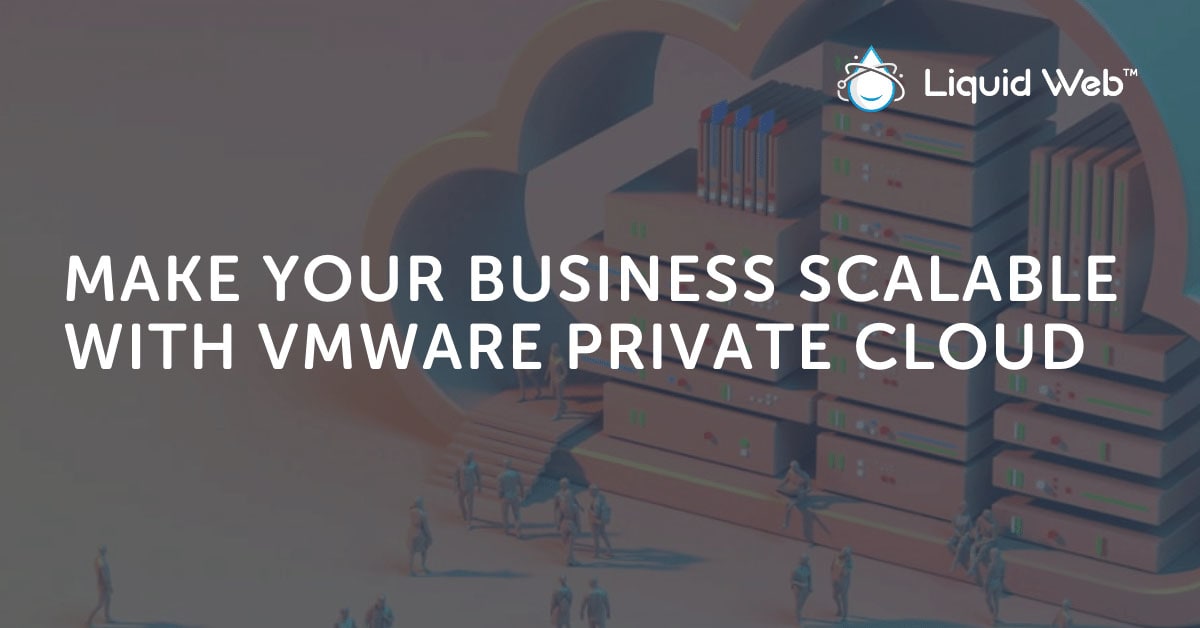
Wondering what a VMware cluster is and how to achieve horizontal or vertical scalability?
Getting more users to your website or application is, without a doubt, a good thing. At some point, however, if the usage continues to grow, you’ll face the problem of scaling your infrastructure capacity to keep your service online.
There are a few ways to get more server capacity, depending on your current server environment (whether it’s on-premise or cloud-based, for example).
One of the easiest and most robust ways to prepare for future growth in any direction with minimal risk and downtime is using VMware Private Cloud supported by VMware clusters.
What is VMware Private Cloud?
To understand VMware Private Cloud, it’s important to know “what is VMware?” in general.
VMware is a leading international cloud infrastructure company, providing virtualization solutions since 1998. For example, you can use VMware to create virtual machines that work like real computers while being powered by separate hardware resources.
VMware Private Cloud is a service that makes connecting all those physical servers possible, so they can share distributed resources across your virtual machines.
In a managed VMware environment, a hosting company can use an ESXi bare metal hypervisor to virtualize physical servers and create virtual machines that work together as a cluster.
A NetApp SAN is the most popular choice for storage networking architecture in enterprise settings, keeping all data within a centralized virtual data center.
When your company is using a VMware Private Cloud, one of the biggest benefits is uptime reliability. Thanks to VMware vSphere, which monitors all server hosts for critical failures, VMware Private Cloud is able to easily switch between virtual machines to keep everything running.
Another advantage is VMware scalability, which lets you create as many new virtual machines as the underlying hardware servers can support — thanks to the flexibility of VMware clusters.

What are VMware Clusters?
A server cluster is a group of servers that share resources, such as memory, CPU, and storage. Bundling up servers in clusters is a powerful way to organize computing resources in a virtualized environment.
A VMware cluster is exactly that. VMware clusters are an aggregate pool of resources that can be activated and used for any specific task. Even though a cluster is made up of separate hardware servers, it’s managed as a single entity, using the same network and storage.
For example, four servers with 2GHz dual-core CPUs and 16 GB of RAM would represent 16GHz of computing power and 64 GB of memory.
All the virtual machines you create run on top of the aggregate computing power of the VMware cluster.
To manage the whole system, you need to use the vCenter Server console, which is part of VMware vSphere but works separately.
In case there’s a vCenter failure, the cluster can continue to power all the virtual machines with vSphere’s High Availability (HA) function. Some other vSphere functions are vMotion, Distributed Resource Scheduler (DRS), and Fault Tolerance (FT).
In addition, vSphere can be used to create new VMware clusters from scratch.
VMware Horizontal Cluster vs Vertical Scaling
When your business is growing rapidly, it’s likely that your server infrastructure needs to be upgraded as well to be able to handle all of the increased traffic.
Accurately predicting and estimating required server resources is one of the most difficult tasks in application hosting.
On the one hand, you don’t want your servers to get overloaded. On the other hand, always having lots of extra capacity available means you’re overpaying for unused computing power.
The solution is to make sure you have the ability to allocate more or fewer resources as your application usage changes.
Your server infrastructure needs scalability.”
Vertical Scaling
Vertical scaling means adding more resources and increasing the capacity of existing hardware servers. The way to do it is by upgrading physical parts (e.g. CPU, RAM, HDDs, network). On the software side, the whole process could be managed through VMware.
Horizontal Scaling
Horizontal scaling is akin to adding an additional layer of abstraction. Instead of improving your existing server, you add another server node to the network. The point of horizontal scaling is to make sure your network requests are distributed among your VMware cluster equally, with proper load balancing in place.
In an ideal world, your server infrastructure would be not either vertically scalable vs horizontally scalable, but both.
You need the flexibility of being able to expand your system in a way that makes sense at any given moment.
Storage Area Network (SAN)
The last point to touch on when it comes to VMware cluster scalability is SAN storage. Storage Area Network (SAN) is a fast and powerful network of devices that allows you to consolidate all block-level storage.
When you connect to a SAN from your server, SAN actually appears like a local disk.
SAN storage is critical for any high-speed server infrastructure since it connects servers to their logical disk units and separates the storage system from the local network, improving performance, security, and recovery capabilities.
Liquid Web and Managed Private Cloud: The Perfect Combination
When you sign up for Liquid Web’s Managed Private Cloud offering powered by VMware and NetApp, you don’t have to worry about scalability, availability, resource optimization, or security at all.
We listen to your business goals and consider your growth trajectory to build your own private cloud using a simple resource-based pricing model, which you can scale up at any time. You can also create an unlimited amount of virtual machines (as long as they can be supported by the underlying hardware servers) to suit your business needs.
Not sure which cloud solution to choose? Simply contact Liquid Web, and one of your technicians would be happy to walk you through the available options and suggest an optimal solution based on your needs today, taking into consideration the scalability you’ll need to grow in the future.
[ad_2]
Source link







